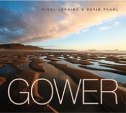Gomer 2009, 144pp, £19.99

It isn’t easy to capture the essence of a region between the covers of a book, even one as compact as Gower, a kind of micro-Cornwall stretching west of Swansea, a peninsula about fifteen miles long and about five miles across. There have been several ‘Gower books’ over the years and the annual volumes of the journal Gower have been, for over fifty years, combining essays with photographs. This handsomely-produced volume consists of ten essays (one of them introductory) and ten poems by Nigel Jenkins, and about eighty seven colour photographs by David Pearl. This is not a topographical or antiquarian travelogue, and the pictures entirely avoid picture-postcard or calendar views. This is simply (or not so simply) two artistic reactions to Gower.
I do not know whether it was deliberately planned that words and pictures would offer very different aspects of the peninsula, but the casual reader who dipped at random into the book, looking only at the photos would get a rather different view from someone reading the text. It is true that the essay on the annual Gower Show is accompanied by lively and humorous photos of the public and some of their animals, but in general the pictures emphasize the extreme wildness of our landscape, lonely, misty marshes along the north coast, savage rocks, cliffs and breakers along the south, and vast heathery brackeny furzy commons in the middle. We have three photo-essays, one devoted to the largely unvisited ‘inland’ of Gower, mysterious combes such as Bishopston Valley, all snowy with ramsons, an essay on plants found on duneland or on natural rockeries on the cliffs, and a third on the coast, giving glimpses of vast strands around Burry Holmes and Llangennith. To accompany the essay on castles we have a few sidelong glances at their ruins – one of the most striking is a view I have never seen elsewhere, of Penrice Castle together with the eighteenth-century house and across to the bay. The essay on farming has some views of farmers at work and some majestic cloudscape over fields of almost East Anglian cornlands. My one complaint about the illustrations is that many of them are very small, and in the margins of the text: on page 71, for example, a glimpse of Oystermouth Castle seen at the end of a street in the Mumbles is too small to be meaningful. Four times the size, it would create a splendid contrast of Victorian bay-windowed terraces and the medieval ruins.
The poems and essays emphasize the human activities on the peninsula, and in the main, can be seen as a contrast to the photography. Nigel Jenkins begins with what is in effect a lament for the passing of the Gower farming life he knew as a child, growing up on Kilvrough Park Farm some fifty years ago. Apart from the nostalgia of that chapter, Nigel Jenkin’s writing is down-to-earth, unsentimental, humane and humorous, as he describes the peninsula of his experience. The essay on limestone, the rock which largely creates the peninsula, is brilliantly written, but it should have been accompanied by a photo of a limekiln or a limestone quarry. There are also essays on Paviland Cave and other archaeological remains, and another on Gower castles, earthworks as well as stone, and yet another on that extraordinary feature of Gower, its vast stretches of common lands. I am a commoner myself, and recall about forty years ago talking to the Commons Commissioners, who suggested that Gower at the time of the Inclosure Acts (frequent in other parts of Wales) was owned by great landowners who were already netting such huge incomes from mineral exploitation on other parts of their South Wales estates, that they could not be bothered to pay for acts of parliament to enclose Gower. There is a charming pen-portrait of Willy Harry, who had a traction engine business back in the 1950’s, and in another of the essays a pen-portrait of Mrs Hearne the gypsy. I clearly recall forty years ago the caravans on the common near Fairwood Hospital looking down over the Dunvant: just where did they all disappear? One of the most interesting essays is that on the industrial past of Gower, not just the limestone quarrying in the south and coal in the north around Penclawdd, but totally foreign industries such as the production of red oxide which we are told here formed the basis of the brown uniforms of the Great Western Railway staff. It would have been good to have had a picture of industrial remains or colliers’ houses around Penclawdd to accompany this excellent essay. The book ends with a humorous and charming pen-portrait of the Gower agricultural show. One element missing perhaps from the book is a treatment of villages, some such as Mumbles and Bishopston now partly absorbed into suburbia, others such as tiny Knelston surviving with chapel and school, yet others such as Reynoldston, a superb example of a Norman colonial settlement around a compact green, still able to boast hotel, post office, church, hall, and shop.
The reader must combine the two elements of this beautiful book, placing the life and history of people in Gower into the wild, lonely, and sometimes sublime landscape background of the peninsula. This is a most original book which successfully avoids the picture-postcard clichés.
Prys Morgan
